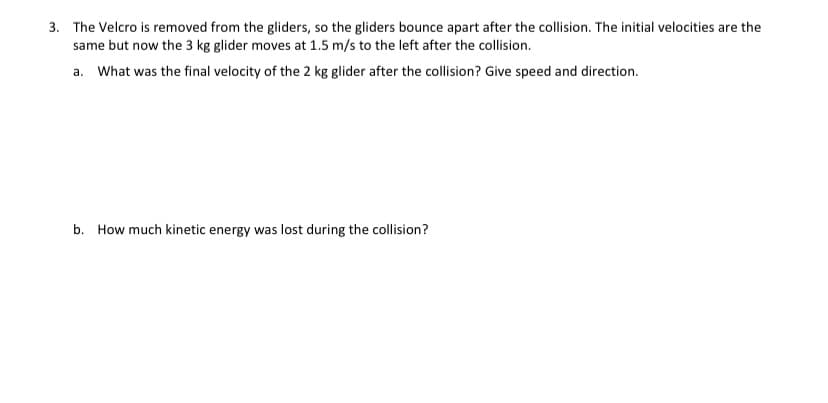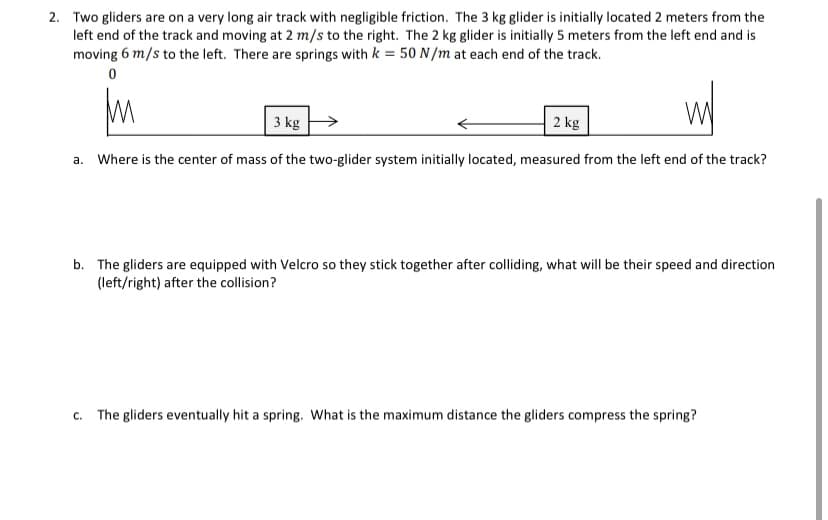The Velcro is removed from the gliders, so the gliders bounce apart after the collision. The initial velocities are the same but now the 3 kg glider moves at 1.5 m/s to the left after the collision. a. What was the final velocity of the 2 kg glider after the collision? Give speed and direction.
The Velcro is removed from the gliders, so the gliders bounce apart after the collision. The initial velocities are the same but now the 3 kg glider moves at 1.5 m/s to the left after the collision. a. What was the final velocity of the 2 kg glider after the collision? Give speed and direction.
Principles of Physics: A Calculus-Based Text
5th Edition
ISBN:9781133104261
Author:Raymond A. Serway, John W. Jewett
Publisher:Raymond A. Serway, John W. Jewett
Chapter7: Conservation Of Energy
Section: Chapter Questions
Problem 7P: Two objects are connected by a light string passing over a light, frictionless pulley as shown in...
Related questions
Topic Video
Question
Only number 3 A and B

Transcribed Image Text:3. The Velcro is removed from the gliders, so the gliders bounce apart after the collision. The initial velocities are the
same but now the 3 kg glider moves at 1.5 m/s to the left after the collision.
a. What was the final velocity of the 2 kg glider after the collision? Give speed and direction.
b. How much kinetic energy was lost during the collision?

Transcribed Image Text:2. Two gliders are on a very long air track with negligible friction. The 3 kg glider is initially located 2 meters from the
left end of the track and moving at 2 m/s to the right. The 2 kg glider is initially 5 meters from the left end and is
moving 6 m/s to the left. There are springs with k = 50 N/m at each end of the track.
3 kg
2 kg
a. Where is the center of mass of the two-glider system initially located, measured from the left end of the track?
b. The gliders are equipped with Velcro so they stick together after colliding, what will be their speed and direction
(left/right) after the collision?
c. The gliders eventually hit a spring. What is the maximum distance the gliders compress the spring?
Expert Solution
This question has been solved!
Explore an expertly crafted, step-by-step solution for a thorough understanding of key concepts.
Step by step
Solved in 2 steps

Knowledge Booster
Learn more about
Need a deep-dive on the concept behind this application? Look no further. Learn more about this topic, physics and related others by exploring similar questions and additional content below.Recommended textbooks for you

Principles of Physics: A Calculus-Based Text
Physics
ISBN:
9781133104261
Author:
Raymond A. Serway, John W. Jewett
Publisher:
Cengage Learning

Physics for Scientists and Engineers, Technology …
Physics
ISBN:
9781305116399
Author:
Raymond A. Serway, John W. Jewett
Publisher:
Cengage Learning

Physics for Scientists and Engineers
Physics
ISBN:
9781337553278
Author:
Raymond A. Serway, John W. Jewett
Publisher:
Cengage Learning

Principles of Physics: A Calculus-Based Text
Physics
ISBN:
9781133104261
Author:
Raymond A. Serway, John W. Jewett
Publisher:
Cengage Learning

Physics for Scientists and Engineers, Technology …
Physics
ISBN:
9781305116399
Author:
Raymond A. Serway, John W. Jewett
Publisher:
Cengage Learning

Physics for Scientists and Engineers
Physics
ISBN:
9781337553278
Author:
Raymond A. Serway, John W. Jewett
Publisher:
Cengage Learning

Physics for Scientists and Engineers with Modern …
Physics
ISBN:
9781337553292
Author:
Raymond A. Serway, John W. Jewett
Publisher:
Cengage Learning

Physics for Scientists and Engineers: Foundations…
Physics
ISBN:
9781133939146
Author:
Katz, Debora M.
Publisher:
Cengage Learning

College Physics
Physics
ISBN:
9781285737027
Author:
Raymond A. Serway, Chris Vuille
Publisher:
Cengage Learning